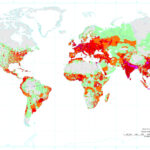We explain what population growth is, its causes and main consequences. Also, growth trends for the future.

What is population growth?
Population growth or demographic growth is the change in the number of inhabitants of a geographic region in a certain period of time. This term is usually used to talk about people, but it can also be used in the study of animal populations.
The study of populations and their dynamics of change allows us to develop theories regarding their growth, as well as predict the consequences in the short, medium and long term. For this reason, demographic growth is the object of study of statistics, demography and other specialized disciplines, as well as an important source of data to design public, social, economic, environmental policies, among others.
The global human population is an example of sustained population growth, especially over the last century. From 2.6 billion in 1950, the figure reached 5.0 billion in 1987 and 7.3 billion in 2015, reaching 8.0 billion today. It is expected that by 2100 the population will reach 10.4 billion inhabitants.
- See also: Urbanization
Causes of population growth

Population growth worldwide is explained by several interrelated factors, including:
- Decreased mortality. Advances in medicine, universal vaccination programs, and improvements in nutrition and access to drinking water have contributed to reducing mortality, especially infant mortality, in virtually every country in the world over the last century.
- Increased life expectancy. Related to the decrease in mortality, in recent decades there has been a significant increase in the average number of years that people live.
- High birth rates. In some regions, especially in peripheral countries, birth rates remain high due to cultural, economic and social factors. Social inequality in access to health and education, as well as high levels of poverty, keep birth rates high.
Consequences of population growth

The main consequences of population increase worldwide are:
- Increased demand for goods and services. The growth of the world population imposes a greater demand for goods, services and resources to satisfy the material needs of more and more people. The sustained demand for resources such as drinking water, food or farmland can generate significant ecological and environmental impacts.
- Increased pollution levels. Population growth increases air, water and soil pollution levels, as well as noise pollution in large cities. The production of waste also increases and its proper treatment becomes difficult.
- Problems in access to basic services. Rapid population growth can hinder the ability of governments to provide basic services such as education, health and housing.
- Impact on the labor market. Population growth can exacerbate economic and social inequality, as pressure on the labor market leads to lower wages and higher unemployment rates.
- Increase in urbanization. Population growth has produced rapid urbanization due to the migration of people from the countryside to the cities. This led, in many cases, to unplanned urban expansion, the formation of slums and the degradation of the population's quality of life.
How is population growth calculated?
Population or demographic growth depends on four elements: birth rate, mortality, immigration and emigration. The difference between births and deaths is called “vegetative growth”, while the difference between people who arrive at a place compared to those who leave is called “migratory balance”.
Therefore, demographic growth is calculated by adding vegetative growth and the migratory balance. Mathematically, it can be expressed as follows:
Demographic growth = Natural growth (births – deaths) + Immigration balance (immigration – emigration)
Countries with the highest population growth

The countries with the fastest population growth rates are mostly African. However, the country with the highest growth is Oman, located in Asia.
| Country | Continent | Population growth rate (annual) |
|---|---|---|
| Oman | Asia | 4.51% |
| Chad | Africa | 4.36% |
| Syria | Asia | 4.31% |
| United Arab Emirates | Asia | 4.12% |
| Somalia | Africa | 3.47% |
| Central African Republic | Africa | 3.46% |
| Niger | Africa | 3.45% |
| Democratic Republic of the Congo | Africa | 3.31% |
| Angola | Africa | 3.27% |
| Yemen | Asia | 3.27% |
Countries in balance or with negative growth
In some countries, the birth rate is almost equal to the death rate, resulting in a population that has stopped growing, regardless of migration phenomena. This occurs in nations with high levels of economic development, where in recent years the number of children per family has decreased. An example of this phenomenon can be observed in countries such as Finland or Sweden, in Europe.
Besides, There are countries that face negative population growth, where the mortality rate exceeds the birth rate or where emigration levels are high.. This phenomenon occurs in developed nations, where the aging of the population and the reduction in fertility rates lead to a gradual decrease in the number of inhabitants, such as in Japan. It also occurs in countries at war or with prolonged military conflicts, such as Ukraine.
The trend of population growth
The global population has experienced an accelerated increase since the second half of the 20th century due to reduced general mortality and infant mortality rates and increased life expectancy.
However, In recent years, the pace of growth has begun to slow down. According to projections, the world population is expected to reach peak growth in the mid-21st century, followed by stabilization or even decline in some regions.
Population growth is uneven in different parts of the world. While many regions of Africa and some parts of Asia still have high rates, other continents such as Europe and North America face slower growth or even population decline.
Some projections estimate that the world population will reach 8.5 billion in 2030. 9.7 billion in 2050 and 10.4 billion in 2100.
document.addEventListener(“DOMContentLoaded”, (e) => {
var sliderContainer, slider;
sliderContainer = document.getElementById(‘block_feb850a6d378801792646c04a6c15e49’);
if (typeof initSlider !== ‘function’) {
console.log(‘Swiper haven\’t been loaded’);
sliderContainer.className += ‘ fw scroll-snap’;
return;
};
options = {
direction: ‘horizontal’,
speed: 1000,
slidesPerView: ‘auto’,
// slidesPerGroup: 1,
centerInsufficientSlides: true,
// centeredSlides:true,
spaceBetween: 15,
breakpoints: {
720: {
// centeredSlides: false,
// slidesPerGroup: 2,
spaceBetween: 25
},
},
pagination: {
el: ‘.swiper-pagination’,
type: ‘bullets’,
clickable: true
},
}
slider = initSlider(sliderContainer, options);
})
References
- Melo, M. (2022). How many people will there be in the world in 2100?. Statist. https://es.statista.com/
- United Nations. (sf). Population. https://www.un.org/es/
- StatisticsTimes. (2024). List of Countries by Population Growth Rate. https://www.statisticstimes.com/





